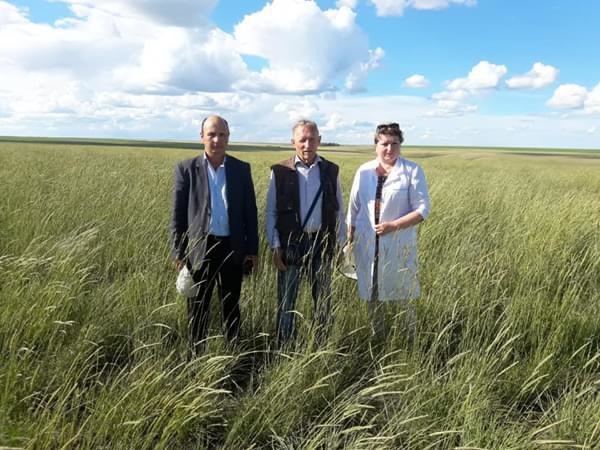
Scientists of the subsidiary organization of the “National agrarian science and educational center” JSC – “Ural Agricultural Experimental Station” LLP have developed a special sowing technology that ensures full germination and preservation of seeds of perennial grasses.
Léymus is a real find for steppe grassland farming in western Kazakhstan. The homeland of the Léymus is the steppes of Northern Kazakhstan and Western Siberia. It also grows wild in the area between the Volga and the Urals.
Clinelymus sibiricum L.is a perennial loose-shrub top cereal with a height of 80-130 cm. It provides a good yield of pasture mass in early spring and spring, it has early growth in spring, good aftermath and has a high durability.
It drew attention in the early 90s of the last century, when there was an urgent need to return fallow lands and degraded areas of pastures to economic circulation using perennial grasses. It was found that the expansion of sowing of perennial grasses and their mixtures to 40-50% of arable land will allow to restore the original fertility in 5-7 years, as well as provide all available livestock in the stall period with hay, and in the summer with full-fledged pastures.
A large research and implementation work in this direction was carried out by the team of the subsidiary organization of the “National agrarian science and educational center” JSC – “Ural Agricultural Experimental Station” LLP, headed by Viktor Ivanovich Buyankin, the head of the enterprise, candidate of agricultural sciences. As a result, by 1998, perennial grasses occupied more than 42% of the station's arable land. This became possible as a result of the development of a special sowing technology that ensures the full germination of seeds of perennial grasses, the preservation and good development of the resulting seedlings in the first year of life, high productivity of hayfields in the next 7-8 years, and pastures up to 15 years or more. At the same time, the issues of the production of seeds of perennial grasses were resolved for subsequent annual grassing and sale.
During 11 years at the station, about 30 large arrays with an area of 100 to 550 hectares were made meadow formation. The total sowing area of various types of grass mixtures and grass seed plants reached 8.5 thousand hectares. This included cereal-legume grass mixtures for haymaking purposes, grass mixtures of cereal grasses sown for the purpose of mowing in the first 3 years and subsequent transformation into grazing lands, as well as wide-row sowing of wheatgrass testes, sainfoin, melilot, and Clinelymus sibiricum L.

Of the 8.5 thousand hectares of perennial grasses sown by the end of the 1990s, at the “Ural Agricultural Experimental Station” LLP, by 2020, grasses were preserved on six remote arrays, with a total area of about 1.6 thousand hectares.
Especially at that time, it was paid attention to the Léymus or Clinelymus sibiricum L., the potential of which to this day remains unappreciated by rural commodity producers. From one hectare of its crops in the dry steppe, up to 50 centners of pasture feed containing 13-14 centners of feed units and up to 1.7 centners of digestible protein are obtained. Moreover, it is possible to graze livestock in our conditions already from mid-April to late autumn.
Nowadays, the fields sown by the Léymus 26 years ago are still productive. Léymus survived all the components of the grass mixture of the culture (sweet clover, sainfoin), displaced competing forbs, and perfectly renews itself over time with minimal maintenance.


